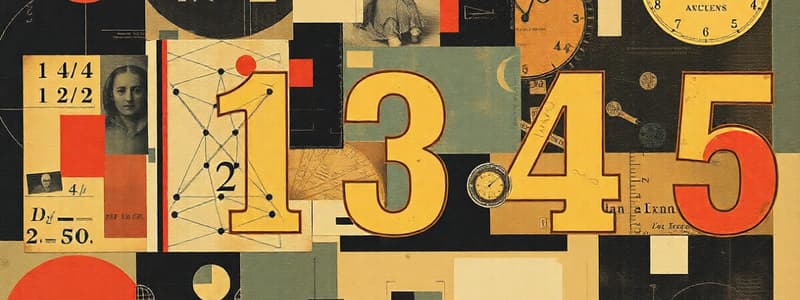Podcast
Questions and Answers
Which of the following sets of numbers is included in the real number system?
Which of the following sets of numbers is included in the real number system?
- Whole numbers without fractions
- Rational and irrational numbers (correct)
- Negative integers only
- Natural numbers only
Which statement accurately describes whole numbers?
Which statement accurately describes whole numbers?
- Whole numbers are only odd numbers.
- Whole numbers do not include zero.
- Whole numbers can be negative.
- Whole numbers include all natural numbers and zero. (correct)
Which property states that the order of addition does not affect the result?
Which property states that the order of addition does not affect the result?
- Distributive Property
- Commutative Property (correct)
- Identity Property
- Associative Property
Which of the following numbers is an example of a rational number?
Which of the following numbers is an example of a rational number?
What distinguishes irrational numbers from rational numbers?
What distinguishes irrational numbers from rational numbers?
Which of the following statements about integers is true?
Which of the following statements about integers is true?
Which property of real numbers states that for any two real numbers, one is greater, less than, or equal to the other?
Which property of real numbers states that for any two real numbers, one is greater, less than, or equal to the other?
Which of these numbers is classified as an irrational number?
Which of these numbers is classified as an irrational number?
Flashcards
What are real numbers?
What are real numbers?
Numbers that can be represented on a number line, including all positive and negative numbers, fractions, and decimals.
What are natural numbers?
What are natural numbers?
Positive whole numbers starting from 1 (1, 2, 3, ...). Used for counting.
What are whole numbers?
What are whole numbers?
All natural numbers plus zero (0, 1, 2, 3, ...)
What are integers?
What are integers?
Signup and view all the flashcards
What are rational numbers?
What are rational numbers?
Signup and view all the flashcards
What are irrational numbers?
What are irrational numbers?
Signup and view all the flashcards
What is the closure property of real numbers?
What is the closure property of real numbers?
Signup and view all the flashcards
What is the commutative property of real numbers?
What is the commutative property of real numbers?
Signup and view all the flashcards
Study Notes
Real Number System Overview
- The real number system encompasses all numbers that can be represented on a number line.
- It includes natural numbers, whole numbers, integers, rational numbers, and irrational numbers.
Natural Numbers
- Natural numbers are positive integers starting from 1 (1, 2, 3, ...).
- They are used for counting.
- A subset of whole numbers and integers.
Whole Numbers
- Whole numbers include all natural numbers and zero (0, 1, 2, ...).
- Zero represents the absence of quantity.
- A subset of integers.
Integers
- Integers are whole numbers and their negative counterparts (... -3, -2, -1, 0, 1, 2, 3, ...).
- Include positive and negative whole numbers.
- Zero is an integer.
Rational Numbers
- Rational numbers are expressible as a fraction p/q where p and q are integers, and q ≠ 0.
- Examples include 1/2, 3/4, -2/5, and 7.
- Any terminating or repeating decimal can be expressed as a rational number.
Irrational Numbers
- Irrational numbers cannot be expressed as a fraction of two integers.
- Their decimal representations are non-terminating and non-repeating.
- Examples include π (pi), √2 (the square root of 2), and e (Euler's number).
Real Number Properties
- Closure: The sum or product of two real numbers is always a real number.
- Commutative Property: The order of addition or multiplication doesn't change the result (a + b = b + a, a × b = b × a).
- Associative Property: The grouping of numbers in addition or multiplication doesn't change the result (a + (b + c) = (a + b) + c, a × (b × c) = (a × b) × c).
- Distributive Property: Multiplication distributes over addition (a × (b + c) = a × b + a × c).
- Identity Property: The additive identity is 0 (a + 0 = a), and the multiplicative identity is 1 (a × 1 = a).
- Inverse Property: Every real number has an additive inverse (opposite) and a multiplicative inverse (reciprocal) (a + (-a) = 0, a × (1/a) = 1, a ≠ 0).
- Order Property: Real numbers are ordered; for any two real numbers a and b, either a = b, a < b, or a > b.
Real Number Line
- The real number line visually represents the real numbers.
- Each point on the line corresponds to a unique real number.
- Positive numbers are to the right of zero, and negative numbers are to the left.
Subset Relationships
- Natural numbers are a subset of whole numbers.
- Whole numbers are a subset of integers.
- Integers are a subset of rational numbers.
- Rational and irrational numbers together form the set of real numbers.
Studying That Suits You
Use AI to generate personalized quizzes and flashcards to suit your learning preferences.




